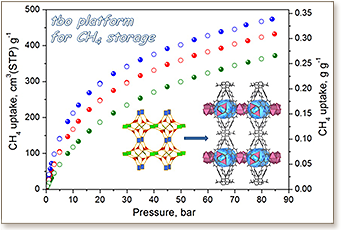

 Successful implementation of reticular chemistry using a judiciously designed rigid octatopic carboxylate organic linker allowed the construction of expanded HKUST-1-like tbo-MOF series with intrinsic strong CH4 adsorption sites. The Cu-analogue displayed a concomitant enhancement of the gravimetric and volumetric surface area with the highest reported CH4 uptake among the tbo family, comparable to the best performing metal organic frameworks (MOFs) for CH4 storage. The corresponding gravimetric (BET) and volumetric surface areas of 3971 m2 g–1 and 2363 m2 cm–3 represent an increase of 115% and 47%, respectively, in comparison to the corresponding values for the prototypical HKUST-1 (tbo-MOF-1), and are 42% and 20% higher than that of tbo-MOF-2. High-pressure methane adsorption isotherms revealed a high total gravimetric and volumetric CH4 uptakes, reaching 372 cm3 (STP) g–1 and 221 cm3 (STP) cm–3, respectively, at 85 bar and 298 K. The corresponding working capacities between 5 and 80 bar were found to be 294 cm3 (STP) g–1 and 175 cm3 (STP) cm–3 and are placed among the best performing MOFs for CH4 storage particularly at relatively low temperature. To gain insight on the mechanism accounting for the resultant enhanced CH4 storage capacity, molecular simulation study was performed and revealed the presence of very strong CH4 adsorption sites near the organic linker with similar adsorption energetics as the open metal sites. The present findings support the potential of tbo-MOFs based on the supermolecular building layer (SBL) approach as an ideal platform to further enhance the CH4 storage capacity via expansion and functionalization of the quadrangular pillars.
Successful implementation of reticular chemistry using a judiciously designed rigid octatopic carboxylate organic linker allowed the construction of expanded HKUST-1-like tbo-MOF series with intrinsic strong CH4 adsorption sites. The Cu-analogue displayed a concomitant enhancement of the gravimetric and volumetric surface area with the highest reported CH4 uptake among the tbo family, comparable to the best performing metal organic frameworks (MOFs) for CH4 storage. The corresponding gravimetric (BET) and volumetric surface areas of 3971 m2 g–1 and 2363 m2 cm–3 represent an increase of 115% and 47%, respectively, in comparison to the corresponding values for the prototypical HKUST-1 (tbo-MOF-1), and are 42% and 20% higher than that of tbo-MOF-2. High-pressure methane adsorption isotherms revealed a high total gravimetric and volumetric CH4 uptakes, reaching 372 cm3 (STP) g–1 and 221 cm3 (STP) cm–3, respectively, at 85 bar and 298 K. The corresponding working capacities between 5 and 80 bar were found to be 294 cm3 (STP) g–1 and 175 cm3 (STP) cm–3 and are placed among the best performing MOFs for CH4 storage particularly at relatively low temperature. To gain insight on the mechanism accounting for the resultant enhanced CH4 storage capacity, molecular simulation study was performed and revealed the presence of very strong CH4 adsorption sites near the organic linker with similar adsorption energetics as the open metal sites. The present findings support the potential of tbo-MOFs based on the supermolecular building layer (SBL) approach as an ideal platform to further enhance the CH4 storage capacity via expansion and functionalization of the quadrangular pillars.